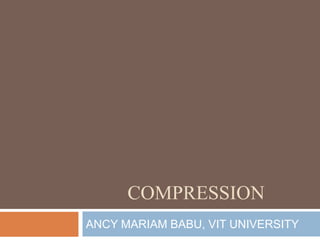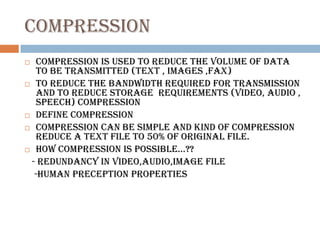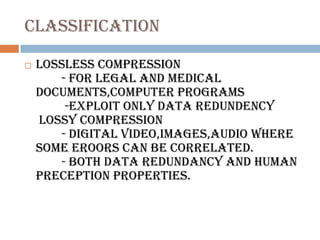Compression
- 1. COMPRESSION ANCY MARIAM BABU, VIT UNIVERSITY
- 2. Compression ïĻ Compression is used to reduce the volume of data to be transmitted (text , images ,fax) ïĻ To reduce the bandwidth required for transmission and to reduce storage requirements (video, audio , speech) Compression ïĻ Define compression ïĻ Compression can be simple and kind of compression reduce a text file to 50% of original file. ïĻ How compression is possibleâĶ?? - redundancy in video,audio,image file -human preception properties
- 3. Compression
- 4. Classification ïĻ Lossless compression - for legal and medical documents,computer programs -exploit only data redundency lossy compression - digital video,images,audio where some eroors can be correlated. - both data redundancy and human preception properties.
- 5. Video compression ïĻ Video as a sequence of pictures or frames ïĻ Exploits only spatial redundancy ïĻ High correlation between successive frames.only small portion of each frames is involved with any motion that is taking place ïĻ The combination of actual frame content and predicted frame content are used.
- 6. Video compression techniques ïĻ The examples are: ïĻ Avi : audio video interleave -used to store audio and video data in file - formatted as ïĻ JPEG2000: COMPRESSION STANDARD FOR STILL IMAGE -LOWER LATENCY - TYPE OF LOSSLESS COMPRESSION ïĻ MPEG2 &MPEG4: VIDEO COMPRESSION STANDARD - WIDELY USED TO DVD DISCS AND DIGITAL TELEVISON BROAD CASTING - USED IN As ENCODER BEFORE TRANSMISSION






